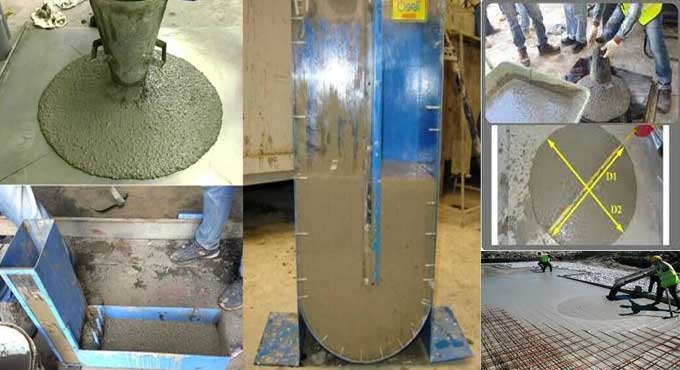
Standard Test Methods for Self Compacting Concrete
Concrete that self-compacts differs slightly from conventional concrete. Self-compacting concrete has three main characteristics: filling capacity, breaking capacity, and segregation resistance.
To be able to assess these characteristics, it is very important to perform field trials or mock trials. However, the properties of any of those compounds have not so far been successfully measured by any single test.
Many organizations have developed and use several tests, but none of them are standardized and all are elementary in nature.
In general, the following tests are used:
? Slump Flow
? V Funnel
? L Box
? U Box
? Fill Box
Slump Flow Test
This test was originally developed in Japan. It can be used to evaluate underwater concrete from a water depth of 30 feet. Filling ability tests and detection of SCC are both carried out using the test most commonly.
The tests will not indicate how well the concrete can pass between the reinforcement without blocking, but they may indicate how well it resists segregation.
In this test, you can check how consistent the supply of ready mix concrete is at the construction site, which has been designed after assessing various characteristics as a result of the above five tests and more.
V-Funnel Test
V-Funnel Test is used to determine the ability of concrete to flow and resist segregation.
Test execution procedures are as follows:
- Position the V-funnel with support arrangements on a firm, level surface.
- Close the trap door after thoroughly wetting the internal surfaces with a damp sponge.
- The concrete should be poured from the top, with no external efforts to level it or compact it.
- With the funnel filled, quickly open the trap door without applying any pressure to the set-up.
- T0 is the time required for the funnel to be empty in seconds.
- This procedure must only be repeated with the exception that the trap door will be opened after 5 minutes of complete filling, and no funnel will be emptied in less than 5 seconds, which is T5.
- The guidelines state that the time from the start of the test, T0, should be between 8 and 12 seconds, and the time from the end of the test, T5, should be less than 3 seconds.
- If T5 is more than 3 seconds ahead of T0, there is a risk of the SCC mix segregating.
L- Box Test
In the 'L' Box test, the ability of Self Compacting Concrete to pass and fill is primarily assessed. In its simplest form, the apparatus is a rectangular box in an "L" shape.
Unlike steel, concrete passes through known clearances without a problem. To allow concrete to flow into the horizontal section, the vertically positioned steel bars are raised so that concrete can flow into the vertical section.
In the vertical box next to the obstruction, the height of the concrete h2 is measured along with the height of the vertical box h1 at the end of the flow.
A ratio of h2/h1 is used to measure SCC's passing ability. Between 0.80 and 1.0 should be the blocking value for SCC. Blocking values of zero or less indicate a high viscosity. When the ratio is close to 1, it indicates false results.
In addition to passing ability, segregation resistance can also be observed visually during the test. In case of concrete building up on reinforcement bars, either the concrete is blocked or it segregates.
U-Box Test
The purpose of this test is to determine whether self-compacting concrete can be passed.
It is designed in a U shape, and a sliding gate is fixed between the two compartments, with vertical steel bars as obstructions.
The concrete is forced to flow over the obstructions, and the level difference between the top surfaces in each compartment is measured.
Fill Box Test
Concrete with self-compacting properties can be assessed with this test. In this apparatus, concrete is forced to flow through obstructions within a rectangular box.


